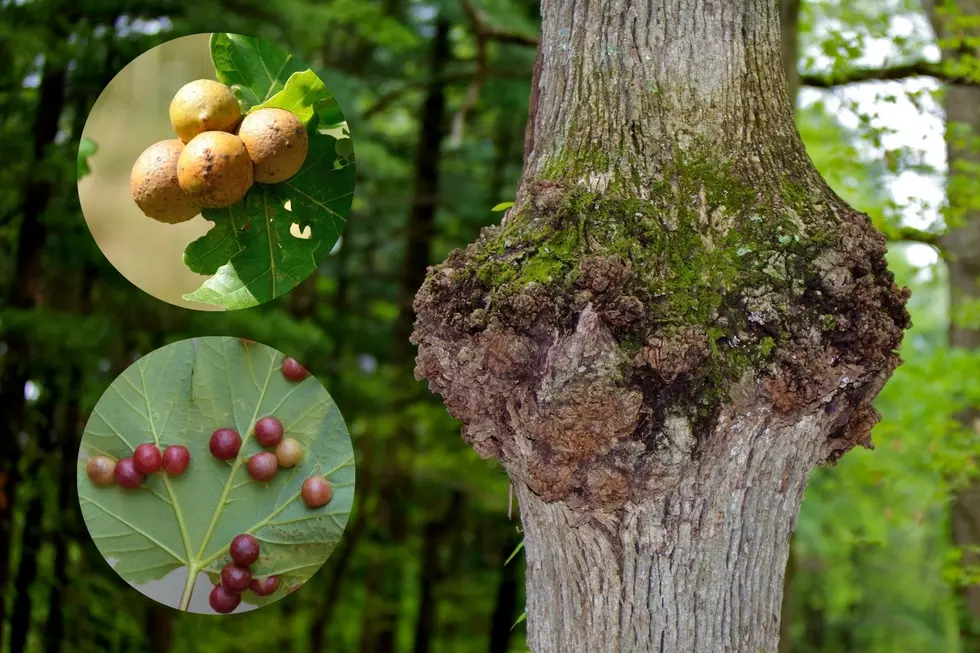
What Are Those Tumorous Growths on Iowa Trees?
After a recent hike through Pinicon Ridge Park in Central City, Iowa, I noticed that many of the oak trees along the white oak trail we hiked were covered in numerous gnarled-looking growths all along their trunks and limbs. I've seen growths like this before, but never in the abundance that they were in along this trail. So, that got me wondering, what in the world are those strange growths and are they beneficial or dangerous for the trees?
So what are those nasty-looking bumps on our oak trees?
These abnormal growths, called galls, affect only the appearance of the trees and are not detrimental to plant health. Galls are a plant's response to insects, mites, bacteria, fungi, or nematodes. Galls are created by the plants in response to some stimulus from the invading organism. The majority of these insect galls are produced by wasps, and over 700 of these wasp-produced galls occur on oak trees and leaves.
An oak gall. They come in various forms.
There's an equally good chance that what you are seeing is a tree burl. A burl, also known as a burr or burr knot depending on the region, is a rounded, often irregular growth found on the trunk or roots of certain tree species, particularly hardwoods and conifers. These formations are typically caused by various stress factors such as injury, infection, or genetic mutations, leading to the abnormal proliferation of dormant buds or the reaction of the tree's cambium layer.
Tree burls are a little more uniform in their development and are sought after by artists and woodworkers for their unique patterns.
Burls are characterized by their unique swirling patterns of bark, resembling fingerprints, and can vary greatly in size and shape. Despite their unusual appearance, burls are generally benign and do not harm the host tree unless they disrupt its vascular system. Instead, they often serve as habitats for insects and animals, contributing to local biodiversity.
Is this a burl or a gall? Your guess is as good as mine on this one. Signs point to a gall in this case.
How exactly is a gall made?
Galls form through a fascinating process initiated by specific organisms, known as "gall-makers," which induce trees to produce a complex array of chemicals and hormones. These substances trigger a rapid multiplication of plant cells, resulting in the formation of the distinctive, abnormal growths we recognize as galls.
These gall-makers are a type of wasp.
The gall serves as a protective environment for the gall-maker, offering shelter and access to essential nutrients. Different types of galls arise from interactions with various organisms, such as insects like wasps, aphids, and mites, each inducing unique structures within the gall. These structures house and protect the immature stages of the gall-maker and can provide a nutrient source for them. Through this intricate interaction between the tree and the gall-maker, galls emerge as intriguing examples of co-reliance in the natural world.
There are so many different bugs that cause so many different types of galls. These galls have formed around the eggs of a certain type of wasp to create protection for both the plant and the insect.
When it comes to the oak tree forest I was in, research shows that Cynipid wasps are the most likely culprit. Here's why: more than 1400 species of these wasp cause galls in trees. Some 1000 of these are in the tribe Cynipini, and guess what? Their hosts are most commonly oak trees and other members of the beech tree family. Other things that can cause these cancerous growths are flies, mites, nematodes, fungi, bacteria, and viruses.
When Should I remove a gall?
Tree galls should be carefully evaluated before deciding whether to remove them. In many cases, the presence of galls does not pose a significant threat to the overall health of the tree. Removing galls can be unnecessary and may even cause more harm when done incorrectly. This can lead to unnecessary damage to the tree or could even spread the disease or fungus if one is present. Galls also serve as habitats for various insects and provide ecological benefits, contributing to biodiversity so removing them isn't usually the right thing to do.
However, there are situations where removal may be warranted, such as when galls cause severe deformities, hinder photosynthesis, or pose safety risks due to falling branches. Ultimately, the decision to remove tree galls should be based on a thorough assessment of the specific circumstances, weighing the potential benefits against the risks to the tree's health and the surrounding environment.

When it's all said and done, the peculiar growths on the oak trees along the trails at Pinicon Ridge Park may initially raise curiosity and questions for hikers (and curious kids). Whether they are galls induced by tiny insects or burls formed due to environmental stresses, these natural phenomena contribute to the intricate tapestry of forest life. While their appearance may seem concerning, it's essential to recognize their benign nature for the overall health of the trees. Rather than viewing them as abnormalities to be removed, we should appreciate them as vital components of the ecosystem, providing habitats for various insects and enhancing our local biodiversity. That's right! It's time to embrace the gnarled, deformed, and grotesque because hey, that's just how life is sometimes.
Explore Iowa! You won't regret it!
Photos: Dubuque's EB Lyons Nature Center and Pine Chapel
Gallery Credit: Tom Drake
Photos: A Trip Through Wild Cat Den State Park
Gallery Credit: Tom Ehlers
